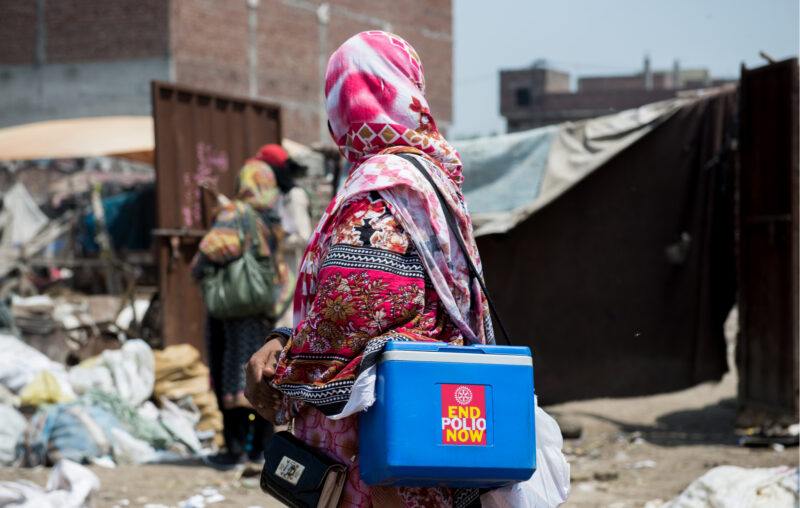In the Midst of Covid-19, Pakistan Continues Its Fight Against Polio

Covid-19 may be the most newsworthy disease these days, but by no means is it the only public health issue that countries are battling. Take Pakistan: The nation has seen over half a million Covid-19 cases and nearly 11,000 deaths, but in addition to that, it faces one of the highest tuberculosis burdens in the world, has a greater prevalence of hepatitis C than all but one country, and has the second-fastest rising HIV rates in Asia.
Pakistan is also fighting a battle that not many need to worry about anymore. It is one of only two nations yet to eradicate wild polio, along with Afghanistan. Nigeria eliminated the wild variant this year, but still experiences vaccine-derived polio. In the space of two generations, what was once the most feared disease in the world has been cornered into a handful of countries.
This is truly extraordinary. In 1988, when the Global Polio Eradication Initiative was founded, 1,000 children were paralyzed by polio every day. But hard work and expensive programs eventually led to a 99.9 percent decrease in polio cases by 2019. That’s no small accomplishment, as total eradication of the disease requires at least 90 percent of a nation’s children to be immunized. The United States eliminated wild polio in 1979 and the disease was eradicated from the Western Hemisphere in 1991.
Pakistan, though, has not yet reached that point. For several years, the country saw a steady decline in polio case numbers. Roughly 20,000 cases were reported annually in the early 1990s; that number had shrunk to a low of just eight cases in 2017. It rose again in 2018 to 12, then spiked to 144 in 2019. Hope for total eradication always seemed to be just out of reach.
With its fragile health system, Pakistan was ill-equipped to handle the stress incurred by its ongoing epidemiological issues in combination with the Covid-19 pandemic. The Global Polio Eradication Initiative (GPEI) paused its vaccination campaigns in March in Pakistan and elsewhere, fearing its efforts would spread Covid-19. This led to 40 million Pakistani children going unvaccinated against polio between April and December 2020.
Pakistani health officials became justifiably concerned about a too-long break in vaccination programs. Hoping to regain their footing, they launched a nationwide anti-polio campaign in late July after Covid-19 case numbers began to decline. By the end of 2020, however, the country had reported 84 cases of wild polio and 83 cases of vaccine-derived polio.
And so, 2021 provides an opportunity for renewed vigor. This week, Pakistani health officials launched a five-day vaccination campaign against polio with the hope of vaccinating 40 million children across the country. Such a short timeline for such a broad campaign reflects the sense of urgency that Pakistan now feels. There is much lost time to make up for––it’s the nation’s first vaccination drive since last summer. Nearly 50,000 teams are now traversing the country to administer the vaccine. This will all make 2021, officials hope, the year that Pakistan will finally be free from polio.
Why, then, has polio been so difficult to quash? Could we not eliminate it the same way we eliminated smallpox in 1979?
Unfortunately, Pakistan still faces challenges in addressing transmission. Polio primarily spreads through fecal-oral routes, while respiratory droplets constitute a minor transmission route. The virus can survive for up to two months outside the body. Each infected person spreads polio to between five and seven others. This all means that overcrowded areas and regions with poor hygiene infrastructure––like Pakistan––are hospitable to polio spread. Vaccination remains the most effective tactic in combating polio, but unwilling and inaccessible populations make eradication campaigns difficult.
Pakistan faces an additional challenge in groups resistant to vaccination campaigns. Taliban forces and rebel militias have long accused health workers of being agents of the West intent on sterilizing children or collecting intelligence. On just day two of the current five-day campaign, gunmen opened fire on a van carrying polio workers.
But despite the arduous road that still lies ahead, Pakistan trudges on. The nation’s health authorities have realized that Covid-19 mitigation is only one component of holistic public health practices. Public health must take all epidemiological factors into account. Tunnel vision only serves to create new kinds of misery, scrapping hard-earned progress.
The World Health Organization initially hoped to eradicate polio by 2000, but shaky mitigation efforts have forced the body to set new benchmarks for eradication on several occasions. It’s a disease that isn’t bound by borders, and countries that are now free of polio could very well see their statuses shift if their neighbors fail to maintain vaccination campaigns. Disrupting global eradication programs ensures that total elimination of polio will slide even further out of reach.
Finally, it bears mentioning that the burden of halted polio vaccination campaigns will necessarily fall on the children of the world. Polio is incurable. The young are at the greatest risk of infection and paralysis. It may well be too late for many of Pakistan’s young, but thankfully, the country’s resumed mitigation efforts signal an awareness that some battles are simply too great to give up in the face of a new pandemic.










